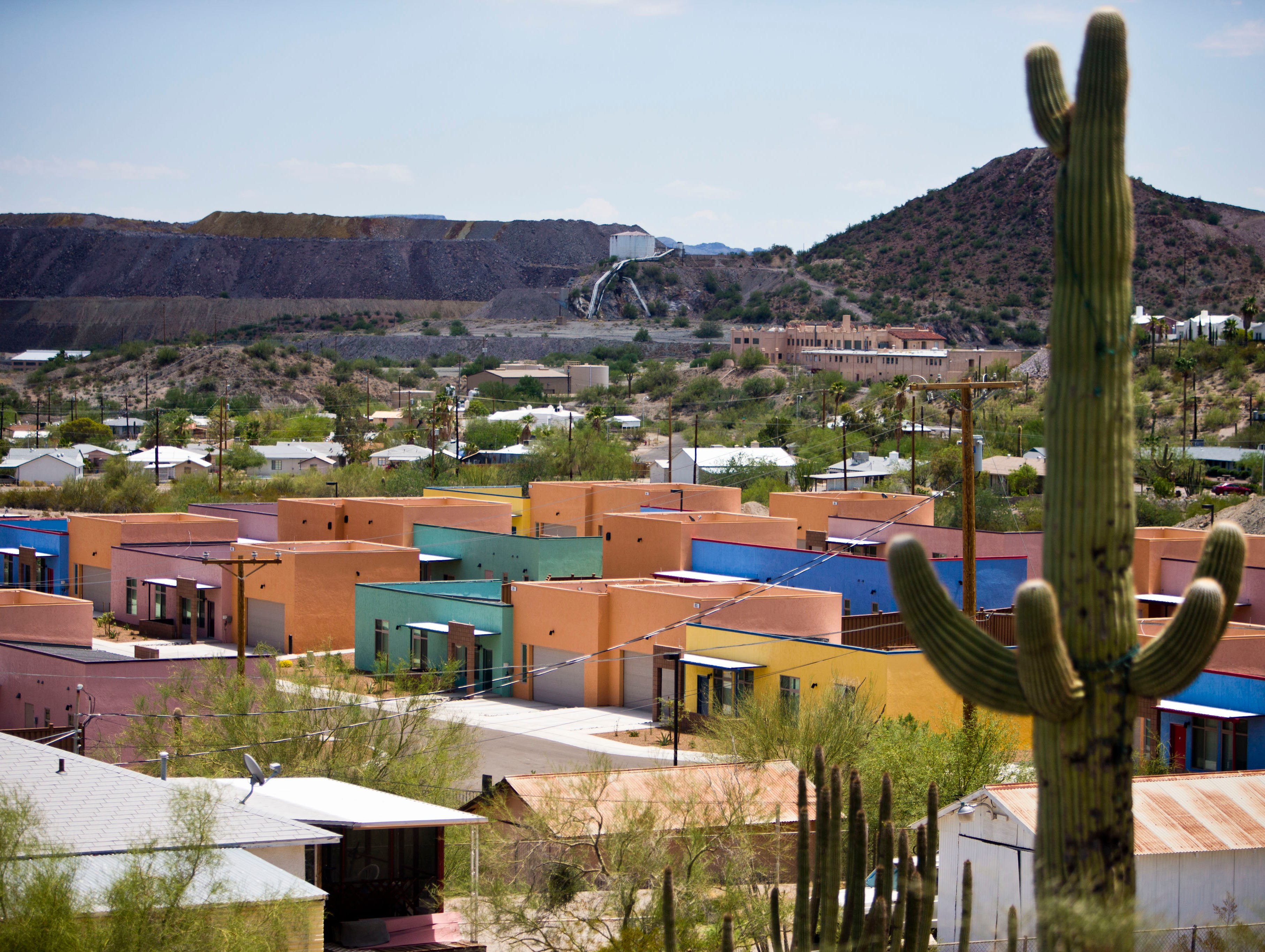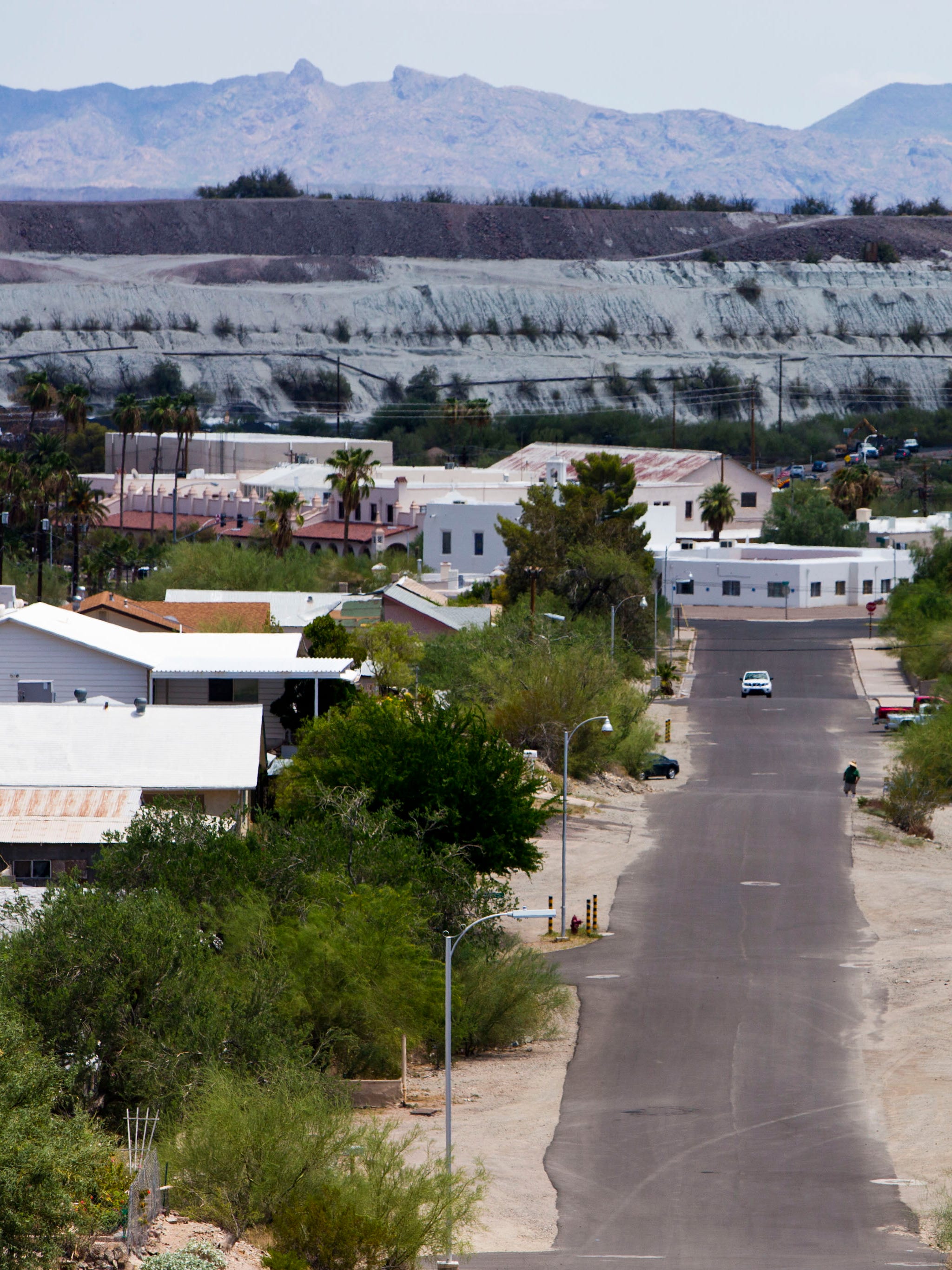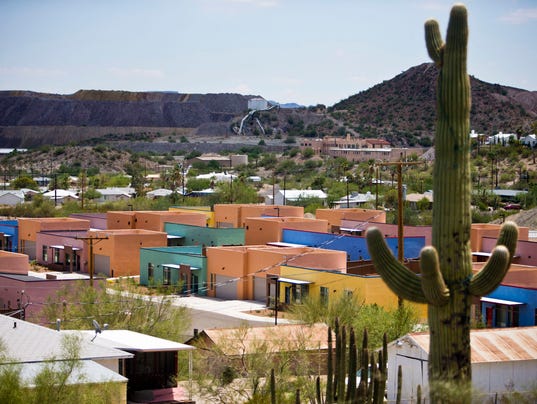Results 1 to 3 of 3
Thread Information
Users Browsing this Thread
There are currently 1 users browsing this thread. (0 members and 1 guests)
-
08-12-2013, 01:38 PM #1
Feds pay millions for border-agent housing in Arizona
Feds pay millions for border-agent housing in Arizona
Brenna Goth , The Arizona Republic 11:41 a.m. EDT August 12, 2013
Cost of building 21 homes in Ajo, Ariz., averages about $600,000 per house.

Customs and Border Patrol paid for construction of a two-block cluster of colorful houses in historic Ajo, Ariz. The federal government spent more than $600,000 each to build 21 houses in Ajo and develop the surrounding area.(Photo: Nick Oza, The Arizona Republic)
Story Highlights
- The new houses are two-, three-bedroom models that range in size from 1,276 to 1,570 square feet
- Older homes of a similar size in community of 4,400 sold for less than $100,000
- Ajo is 40 miles north of the U.S.-Mexican border
AJO, Ariz. — Taxpayers paid millions of dollars for a cluster of yellow, blue and salmon-colored homes that recently sprouted in the desert here, just west of a Spanish colonial revival-style plaza.
The federal government spent, on average, more than $600,000 apiece to plan and build 21 two- and three-bedroom houses and develop the surrounding area to attract U.S. Customs and Border Protection personnel to live in this small former mining community. The new homes range in size from 1,276 to 1,570 square feet.
STORY: More border agents at remote outposts
Most similar-size homes in Ajo sold last year for less than $100,000, according to a database maintained by the Arizona Daily Star.
Altogether, the government has paid $15 million for the homes plus 20 park-model trailers in Ajo, according to documents The Arizona Republic examined.
The homes and trailers are available for Customs and Border Patrol personnel and their families to rent at market rates though the agency declined to answer how much that is, citing privacy concerns.
A Border Patrol station is about 11 miles away in Why, Ariz., and the Lukeville Port of Entry border crossing is about 38 miles away. Both the Border Patrol and Customs personnel work for Customs and Border Protection.
The buildup of federal agents on the border in the past several years has caused housing shortages in cities and towns throughout the Southwest, according to Doris Meissner, who was commissioner of the U.S. Immigration and Naturalization Service in the 1990s and is now a senior fellow at the Migration Policy Institute. But private industry has filled most needs, making the Ajo project — and the money it received — atypical, she said.
“You could buy any house in town for $100,000. It's just another multimillion-dollar waste.”
— Tina West, Western Pima County Community Council"There may be a way to understand that," Meissner said. "On the face, it looks quite startling."
Tina West, a member of the Western Pima County Community Council, was even more blunt about the more than $2 million the government spent on the trailers.
"You could buy any house in town for $100,000," West said. "It's just another multimillion-dollar waste."
The agency repeatedly refused to answer The Republic's questions about the projects. However, in a letter to a local real-estate agent, the agency said the construction cost of the homes was "approximately $167,000 apiece" and the remainder of the money was spent on "acquisitions of various parcels and 12 existing homes; buyout of four life leases; relocation of the private homeowners and rents; excessing or selling the existing homes; design of the new homes and property and infrastructure improvements."
In a statement to the newspaper, the agency said the project gives personnel the option to rent "affordable, high-quality, and energy efficient housing." Housing is not a recruitment tool, the statement said.
Search for housing
Mountains and mine tailings surround this unincorporated area of Pima County, about 40 miles north of the U.S.-Mexican border and 115 miles west of Tucson.
Ajo thrived in the early 1900s during the copper boom but primarily was marketed as a retirement community after the New Cornelia copper mine closed in the 1980s because of plummeting prices.
Now, about 4,400 people live here. Most newcomers are teachers, contractors or border-enforcement agents, residents said.
The median sale price for a single-family home in Ajo is $70,598, according to the Pima County Assessor's Office valuation chart, which used home sale prices from 2010 to 2012 adjusted for current market conditions. Nearly 30% of area houses were vacant from 2007 to 2011, according to statistics from the U.S. Census Bureau.

Ajo, Ariz., leaders and residents worried the government's new homes would not fit the area’s character and would affect local landlords who depend on border-personnel business.(Photo: Nick Oza, The Arizona Republic)
Fewer than 30% of Customs and Border Protection employees assigned to the area rented housing from the Ajo market before the construction, according to a U.S. General Services Administration assessment. Many live in Phoenix, Tucson or Gila Bend, Ariz., and commute an hour or two to the border, which affects staff retention, according to the report.
Agency officials said in letters and reports that not enough high-quality housing was available for agents to live in the area and ramped up efforts to provide its own.
The most recent project is the development that opened in January on South Sahuaro Street. The GSA awarded Tempe-based Sundt Construction Inc. a contract in 2011 for almost $10.4 million to build an enclave of 21 energy-efficient houses as well as streets and sidewalks.
The houses received a Leadership in Energy and Environmental Design platinum rating, according to the GSA. The site is about 11.6 acres and is zoned for an additional 25 houses.
Construction cost more than $11 million in all, according to a Republic analysis of contracts. About $325,000 of the extra expenses went toward problems in developing the land, including rock removal and unforeseen soil conditions, and other money went to upgrading appliances and improving aesthetics.
That total rises to about $13 million including all costs "spent or obligated to this project," wrote Robin Coachman, a Customs and Border Protection housing and project manager based in California, in a 2012 letter to the editor published in the Ajo Copper News.
Early objections
In 2011, the GSA started leasing land at recreational vehicle court less than a mile from the project for 20 agency-owned park-model trailers, which are built for longer stays compared with other mobile homes.
Each trailer cost about $82,000 after the installation of appliances, ceiling fans and other items, according to information that the GSA released to local real-estate agent Linda Sharp under a Freedom of Information Act request. The land lease will cost $436,800 for five years — or about $365 a month per trailer lot.
The agency would not provide square footage for the trailers or answer how many are occupied to protect the privacy of personnel, the agency said in a statement.
<!--iframe-->
Plans for the Sahuaro Street project drew a slew of objections early on from local leaders and residents when federal officials asked for public input in 2010. Some were worried that new housing would not fit with the character of the area while others questioned how the construction would affect local landlords who depend on border-personnel business.
But the new housing could be a real incentive for Customs and Border Protection employees to move here full time — and the area could use their business, said Bety Allen, executive director of the Ajo District Chamber of Commerce. Allen moved to Ajo from Montana with her husband, who is a Border Patrol agent, and said finding suitable rental housing was stressful.
"If those houses would have been there, it would have been so much easier," Allen said.
A cheaper way to provide better options may have been available, said Rep. Raúl Grijalva, D-Ariz., whose district includes Ajo. He said his office suggested renovating homes already in the area.
"I thought it would be good for agents coming in to be integrated into that part of the community," Grijalva said. "It would revitalize part of Ajo."
CBP officials considered renovating 21 separate properties within the community but said it would be more expensive than starting from scratch after the cost of environmental assessments and appraisals, according to Coachman's letter to the editor. He also wrote that not enough homes were available, based on a market survey completed before the project.
Coachman did not respond to interview requests. Arizona's U.S. senators, Republicans John McCain and Jeff Flake, also did not respond to requests for comment.
New homes wanted
The agency's presence in the area has grown substantially in the past several years. The Ajo station was built in Why in 1987 for about 25 agents. A new station opened last year that can accommodate 500.
Ajo has more than enough housing, but it might not be what agents are looking for, said Mari Zimmermann, the designated broker for Ajo Realty. Some houses are ready for moving in, but others need fixing up — and most are old.
"Mostly the younger people who come to town want new houses," Zimmermann said. "We don't have builders. Houses that are new are built by people who live in them."
The Sahuaro Street property is zoned and designed for 46 homes but no money or plans are in place to build the additional 25 homes yet, according to a 2013 letter to Sharp from Eugene Schied, assistant commissioner of the agency's Office of Administration.
Immigration reform could change that, former INS commissioner Meissner said. Housing problems are likely to increase if more agents are sent to the border in the current proposal being considered in the House of Representatives, which could double the number of Border Patrol agents if passed.
"It's going to be a big, new factor," Meissner said. "Nothing along those lines has been discussed."
But not everyone is sure newer properties are enough to draw agents to the area.
Sharp, 63, who rents to several Customs and Border Protection employees, said many agents lease cheap properties close to the border and live full time elsewhere, looking for better schools for their kids, job opportunities for their spouses and the energy of a city.
"Most of them are young," Sharp said. "They want a nightlife, and there's no life in Ajo
http://www.usatoday.com/story/news/nation/2013/08/12/immigration-border-agent-housing/2642491/NO AMNESTY
Don't reward the criminal actions of millions of illegal aliens by giving them citizenship.
Sign in and post comments here.
Please support our fight against illegal immigration by joining ALIPAC's email alerts here https://eepurl.com/cktGTn
-
08-15-2013, 10:58 PM #2
McCain: Border patrol's housing costs 'disgraceful'
Bob Ortega, The Arizona Republic 10:40 p.m. EDT August 15, 2013
Customs and Border Protection spent more than $600,000 each to 21 homes for its personnel in Ajo, Ariz.

The CBP houses are a two-block cluster of colorful houses in historic Ajo, Ariz.(Photo: Nick Oza, The Arizona Republic)
Story Highlights
- 'People should be fired,' McCain says
- Similar-size homes typically cost less than $100,000 in Ajo
- Customs and Border Protection officials haven't offered explanation for cost of housing
PHOENIX -- Members of Arizona's congressional delegation are seeking answers from the Department of Homeland Security on why Customs and Border Protection spent about $15 million for housing in the former mining town of Ajo, Ariz.
At a town hall meeting Tuesday in Tucson, in response to questions about the housing, Sen. John McCain, R-Ariz., said, "It's disgraceful." Asked by a constituent how it could be justified, he replied, "It can't. It can't be; and people should be fired."
As The Arizona Republic reported Monday, CBP paid more than $600,000 each to build 21 modest homes for its personnel in Ajo, a small southern Arizona town where similar-size homes typically cost less than $100,000. CBP also paid more than $2 million to buy 20 park-model trailer homes and lease land on which to park them. The housing project opened in February.
CBP has declined to say how many of the homes and trailers are occupied or how much personnel pay to rent them, other than to say they pay what a spokesman called "market rates."
"We're going to ask for some real answers, and follow up on the tremendous costs," said U.S. Rep. Raul Grijalva, D-Ariz., whose district includes Ajo. "If we don't get a response, we'll ask the [Office of the] Inspector General to take a thorough look at that, and I hope some of my colleagues will join me. I'd bet that this situation is not unique."
STORY: Feds pay millions for border-agent housing in Ariz.
Sen. Jeff Flake, R-Ariz., also said he intends to pursue answers about the housing controversy.
"I'd like to know some more details, but, boy, on its face it looks like a lot of wasted money," Flake said. "On its face, how you can justify spending that much money on new housing is beyond me."
Several other delegation members said they, too, already have or will shortly query Homeland Security about the costs. Rep. Ron Barber, D-Ariz., provided a copy of a letter he sent Thursday to Thomas Winkowski, the acting CBP commissioner, asking for an explanation and justification of the costs and value of the homes and trailers.
Barber said he wants "immediate answers from the Department of Homeland Security on how and why these outrageous expenses were approved."
The controversy over the taxpayer-funded homes comes as Congress debates immigration reforms and whether to massively increase spending on border security, including a possible doubling of the Border Patrol to about 40,000 agents.
With more than $107 billion spent on securing the border over the last seven years, Homeland Security has regularly faced criticism by government audit and budget agencies for ineffective cost oversight.
Customs and Border Protection officials didn't answer queries from The Republic for a detailed explanation of the cost of the Ajo housing. In a written statement, CBP said that the projects followed federal laws, rules and regulations, and that "CBP chose to build housing because quality, affordable housing was not available in the area."
Even before the housing project was built, similar questions arose. In December 2010, Pima County Administrator C.H. Huckelberry complained in a letter to the project manager that a draft environmental assessment "does not contain any cost comparisons," making it impossible to substantiate the CBP's claim that renovating existing housing would be more expensive than building new housing. Huckelberry could not be reached for comment Thursday.
The assessment, by the General Services Administration, the agency that manages most federal property, briefly discussed alternatives such as building homes on existing federal property in Lukeville, 38 miles away near the Sonoyta border crossing, or near the Border Patrol station in Why, 11 miles from Ajo. But the assessment didn't include detailed cost estimates.
Ajo, a town of about 4,400, sits amid piles of mine tailings about 40 miles north of the U.S.-Mexico border. Since the New Cornelia mine closed in 1983, the town has struggled. A GSA assessment for the housing project said that fewer than 30 percent of the CBP personnel assigned to the area rented in the Ajo market before the construction, and that there wasn't adequate housing for agents and officers, a claim some local realtors and property owners have disputed.
According to the U.S. Census Bureau, between 2007 and 2011 nearly 30 percent of the houses in Ajo were vacant. Both Grijalva and Barber said that they see a value in making it easier for agents and Customs officers to live in the community and in ensuring they have adequate housing. But both also said the government needs to protect against wasteful spending.
Grijalva said that his office had previously suggested CBP look at renovating existing housing stock in Ajo. His letter to DHS also raised questions about spending on private detention facilities for undocumented immigrants; it cited The Republic's story as an example of the need for DHS to release more information that can explain why its expenses are justified.
"This looks like a classic example of spending money without worrying about the cost or consequences," Grijalva said.
http://www.usatoday.com/story/news/nation/2013/08/15/mccain-border-patrols-housing-costs-disgraceful/2663317/NO AMNESTY
Don't reward the criminal actions of millions of illegal aliens by giving them citizenship.
Sign in and post comments here.
Please support our fight against illegal immigration by joining ALIPAC's email alerts here https://eepurl.com/cktGTn
-
08-15-2013, 11:20 PM #3
What? The federal government may be wasting money? <sarc>
Support our FIGHT AGAINST illegal immigration & Amnesty by joining our E-mail Alerts at https://eepurl.com/cktGTn


 LinkBack URL
LinkBack URL About LinkBacks
About LinkBacks




 Reply With Quote
Reply With Quote


Durbin pushes voting rights for illegal aliens without public...
04-25-2024, 09:10 PM in Non-Citizen & illegal migrant voters